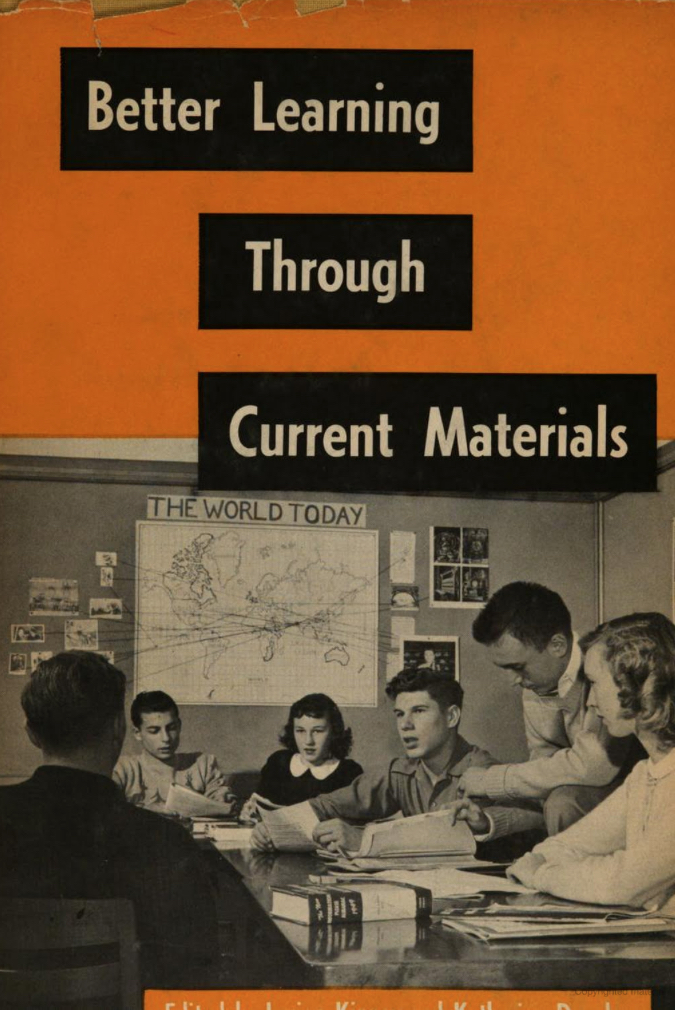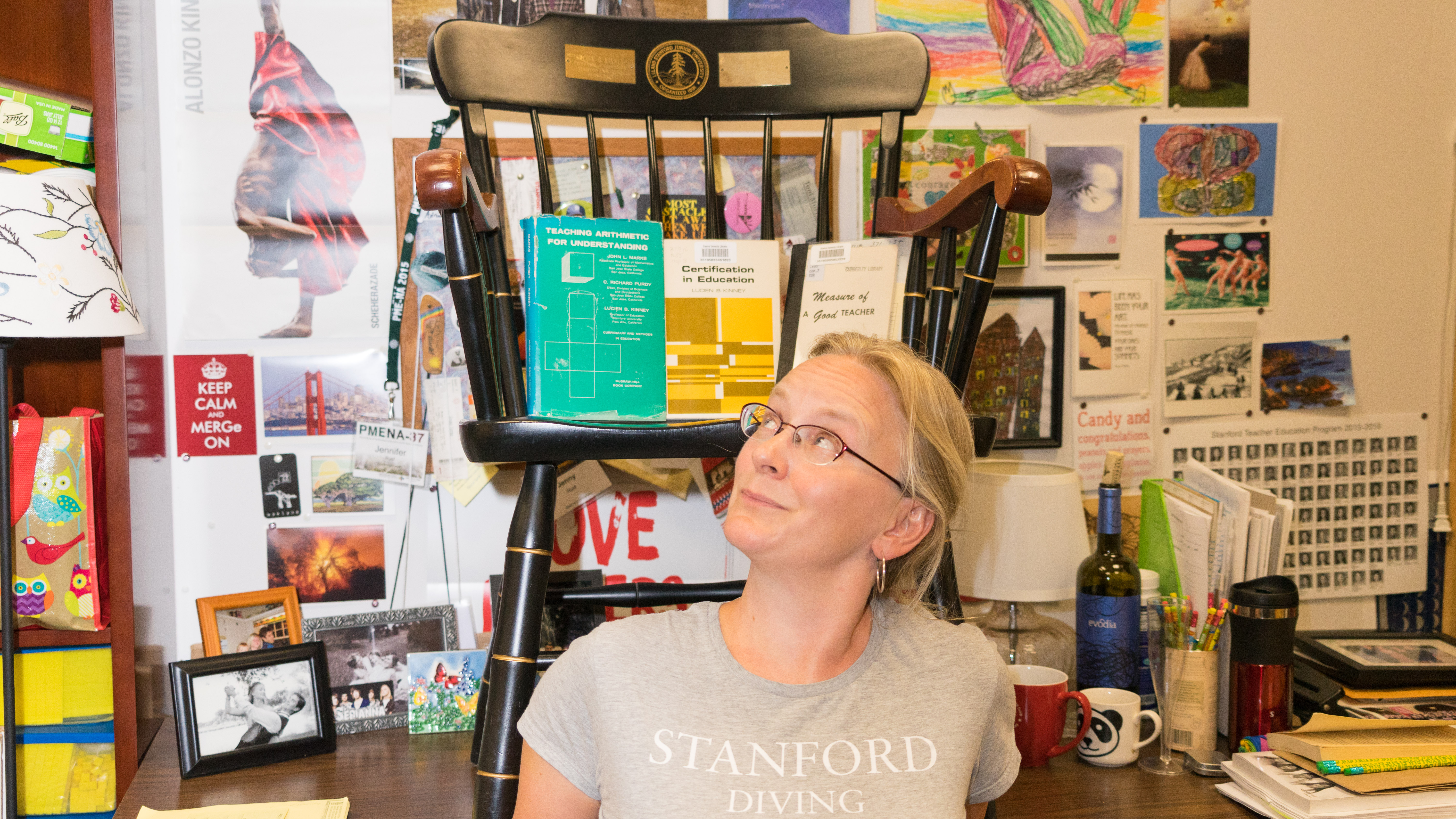I first met Lucien B. Kinney in a dusty basement storeroom. Or rather, I met his chair. Two brass plates nailed to its back read: “In loving memory of Lucien B. Kinney, Professor of Education, Stanford University, 1940-1959,” and “His wisdom and wit are remembered by his students.” It is ebony-black with gold accents including the Stanford seal.
The chair was perched atop a pile of filing cabinets and other pieces of old furniture headed to surplus. I had clearance to take what I wanted. I’ve always admired those chairs — you can still buy them at the Stanford Bookstore — and this one was free. I decided to take it to my office. Kinney was clearly beloved in his time, and I wondered why.
In the fall of 2015, when I liberated the chair, I was writing my doctoral dissertation in education at Stanford, and I had never heard of Professor Kinney. I wondered why not. When I found a black-and-white picture of him, he peered back at me from the 1940s, a composed and somewhat moonlike countenance, bespectacled, with a bald pate. He looked a bit like both Elmer Fudd and my Norwegian grandfather.

I wondered what we might have in common, assuming it would not be much. This stodgy-looking man likely championed musty ideas about learning, and I was engaged in the latest research on the cutting edge of education scholarship. But a surprising thing happened as the year progressed: I discovered that our approaches to education were built on the same ideological bedrock, one that remains the foundation of Stanford Graduate School of Education as it celebrates its centennial.
I came to Stanford as a 20-year veteran middle and high school mathematics teacher, motivated by a sense that our education system could do a much better job teaching the subject and that teachers and students needed a new vision of learning mathematics. In the wake of such policies as No Child Left Behind and Race to the Top, teachers and students have suffered the push to memorize facts and formulas to pass standardized tests. Teachers, and their students, have been disempowered by such policies. My work sheds light on how to move beyond the basic levels of memorizing and calculating to the rich and powerful work of making sense of mathematics.
My dissertation study examined the work done by 60 sixth-grade students and their innovative teacher to shift what it means to be "good at math" from "fast and correct" to "brave, willing to share, and able to explain your thinking." I also examined the classroom norms and practices that supported that shift, and sketched case studies of some of the students' personal "mathematical sensemaker" identities. I came to Stanford inspired by the work of my advisor, Professor Jo Boaler, whose work champions changes in how math is taught today: Less drilling and memorization; more group discussion, creative thinking and visualization. Contrary to popular belief, we are all of us math people, given the right learning conditions.
While working on my dissertation, I found myself wondering about Kinney. As I sat in his chair, it bothered me not to know who he was. It felt important to find him, and I found myself on a scavenger hunt through the university’s libraries, winding up in the basement archives of the Hoover Institution. The documents I encountered included articles and books Kinney had authored; copies of his memorial resolution (not every faculty member gets one); his obituary; letters from another member of the education faculty, Paul Hanna; and a perfect strike in the archival goldmine — a seven-page, single-spaced letter from Kinney to someone named “Larry,” apparently answering a request to detail the pivotal decisions in his life.
My first discoveries included strange coincidences. We were both born in Wisconsin (Kinney in 1895 in Hudson), and he died around the corner from where I lived in Palo Alto, on his lawn Dec. 24, 1971. He was a professor of education who focused on mathematics, and I am in the same profession. Having just earned my PhD, I am now working as Assistant Professor of Mathematics Education at the University of Oregon.
Underlying Kinney’s scholarly concerns was a fundamental question: “How to teach mathematics and why?” In Kinney’s words, during the 1930s mathematics was “on the way out” as a “mental discipline” that smacked of “luxury.” (Later, during World War II, mathematics came roaring back into demand as the “language of science” that undergirded technological war efforts.) Kinney’s deep commitment to teaching mathematics in service of practical efforts speaks to his roots as an engineer—the man started off wanting to build bridges and travel the world. Kinney served as interim Dean of the School of Education from 1942 to 1946, and he created innovative teaching courses to serve a population mobilizing for the war effort.

Throughout his work, Kinney shows early signs of a very contemporary concern — teaching and learning mathematics for understanding. In his time, mathematics education was focused on faithful replication of rules, the procedures of how-to-calculate rather than conceptual understanding, or why-things-work. Kinney’s focus on applied mathematics is a push in the direction of conceptual understanding. In this way, Kinney predated the works of William Brownell in the 1940s and Richard Skemp in the 1970s to move beyond rote calculation (shopkeeper mathematics) to “relational understanding” (Skemp, 1978). While this is currently a cornerstone of mathematics education research, it was not yet a glimmer in anyone’s eyes in the 1930s.
Among many other practical mathematical textbooks, Kinney co-authored Teaching Arithmetic for Understanding, a textbook specifically for teachers. The cover of the book features the net for a cube — its unfolded and flattened surface. This picture speaks to our current times, as recent neuroscience research reinforces what mathematics education researchers have known for decades: encouraging students to make connections between visual and numerical representations strengthens their abilities to make sense of mathematics.
As for empowering the teaching profession, Kinney was deeply concerned with questions of teacher training and certification. He worked with the California Teachers Association to establish strong teaching credentials. He was clearly a champion of teacher certification and licensure as a means to ensure high quality education for all students. He was consistent in this claim: Teaching is a profession, and it should be treated as such.
Unfortunately, the idea that teaching is a profession continues to be controversial. Consider the current push for fast-track preparation, most notably with the national nonprofit Teach for America’s seven-to-10 week training of recent college graduates before placing them in classrooms of underserved students. Kinney’s and my own home state of Wisconsin has been embattled over teaching as a profession on many levels, including a 2015 state budget provision that would have dropped all training requirements for teachers. While at Stanford I was inspired to learn about advances in teacher preparation by such scholars as Boaler, Deborah Ball, Linda Darling-Hammond, Megan Franke, and Pam Grossman. The empirical evidence is clear: Teaching is a complex and challenging profession, worthy of top-notch training and preparation programs.
In 1958, Kinney wrote about the nature of educational progress: “Changes in education come more slowly than we might wish, and as we adjust to them we take them for granted.” He added that we often are unable to see how different things have become. “Rip [Van Winkle], as a teacher, might be puzzled by the emphasis on meaning in arithmetic which he would find in modern textbooks in contrast with the emphasis on rote memory in the thirties. He would need to adapt his thinking to another swing of the curricular pendulum,” Kinney wrote. “His practices would need to be reoriented to new social needs.”
It was not that surprising to find that today we are still solving similar problems of education, such as making the case for high-quality teacher preparation. Some (even Kinney) claim that debate over issues of education swings like a pendulum, sweeping across the spectrum of teaching beliefs and practices, and across the decades. It is more accurate to say the debate tracks an upward-moving spiral, covering the same ground, but improving our understanding and the outcomes for student learning.
Kinney presaged the spiraling shifts in belief that have governed and will govern education (particularly mathematics education) for decades to come. I am pleased to see that I am contributing to those shifts, and that I have been part of an institution that has continued to push for them.
That’s why Kinney’s chair lives in my new office at the University of Oregon, where it can spark questions from new students. It serves as a reminder of the never-ending process of learning about education.

